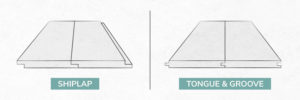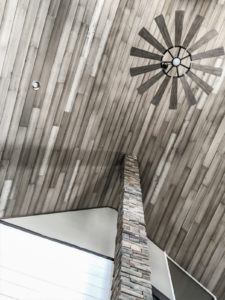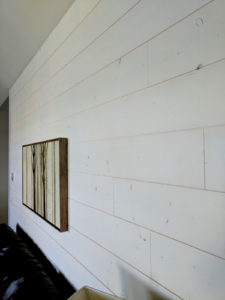Tongue and groove versus shiplap, which one is better?
Posted: August 7, 2023Updated 6/27/2025
Author – Ryan Palma Owner/CEO Sustainable Lumber Co.
Click here to view our extensive line of sustainable wood wall boards. Receive a delivered price to your project by clicking here.
Which is better, tongue and groove or ship-lap?
 The choice between Shiplap cladding vs. tongue and groove primarily depends on personal preference and the specific application. Both T&G and shiplap are popular styles of paneling used in interior and exterior design, particularly for walls and ceilings. Here’s a comparison of Shiplap cladding vs. tongue and groove to help you understand the difference and make an informed decision as to which one is better:
The choice between Shiplap cladding vs. tongue and groove primarily depends on personal preference and the specific application. Both T&G and shiplap are popular styles of paneling used in interior and exterior design, particularly for walls and ceilings. Here’s a comparison of Shiplap cladding vs. tongue and groove to help you understand the difference and make an informed decision as to which one is better:
Design and Appearance
- Tongue and Groove: T&G, like in our blue pine wall paneling, features interlocking boards with a groove on one side and a corresponding tongue on the other. When installed, the boards fit tightly together, creating a seamless, smooth surface.
- Shiplap: Shiplap consists of boards with a rabbet or groove cut on one edge and a matching overlapping edge on the other. When installed, the overlapping boards create distinctive horizontal gaps or reveals between each board.
 Installation
Installation
- Tongue and Groove: T&G paneling requires precise fitting of the interlocking boards. This installation method provides a tighter joint, making it more suitable for applications where a seamless appearance is desired. One nice advantage T&G has over Shiplap is the absence of nail heads. T&G is typically nailed through the tongue at an angle. The groove side of the board then hides the nail heads, making a very nice clean installation. T&G requires more time and effort to install compared to Shiplap.
- Shiplap: Shiplap is relatively easier and quicker to install due to its overlapping nature. The boards can be installed horizontally or vertically, depending on the desired aesthetic. The gaps between the boards add character and a defined line as well. Shiplap boards are required to be nailed directly through the face of the board. Seeing the nail heads can be unsightly so many times they are filled with putty and painted creating a more timely installation.
Durability and Maintenance
- Tongue and Groove: T&G paneling offers a tighter and more secure fit, which can result in better protection against moisture, drafts, and insects. It is commonly used in areas where maintaining a controlled environment or weather resistance is crucial.
- Shiplap: With its overlapping design, shiplap may not provide as tight of a seal as T&G, potentially allowing for more air movement and moisture penetration. However, when installed correctly and properly maintained, shiplap can still be durable and suitable for various applications.
Versatility
Tongue and Groove: T&G paneling is known for its seamless appearance, making it a popular choice for more formal or contemporary designs. It can be used for floors, walls, and ceilings, providing a clean and polished look.
- Shiplap: Shiplap offers a more rustic, nostalgic, and farmhouse-style aesthetic due to its visible gaps and overlapping boards. It is often used for accent walls, ceilings, or in spaces where a more relaxed and textured look is desired.
Ultimately, the choice between shiplap cladding vs. tongue and groove and figuring out which is better comes down to personal style, desired aesthetic, and specific requirements of the project. Both options have their own unique characteristics and can create stunning results when used appropriately. You can take a look at our Skiplap paneling for interlocking wood cladding.
Our knowledgeable and educated staff is here to answer any additional questions you may have. Please call us today for a free quote: Ph# 406.642.7120 or click here to submit an inquiry online. We look forward to working with you on your next project!



